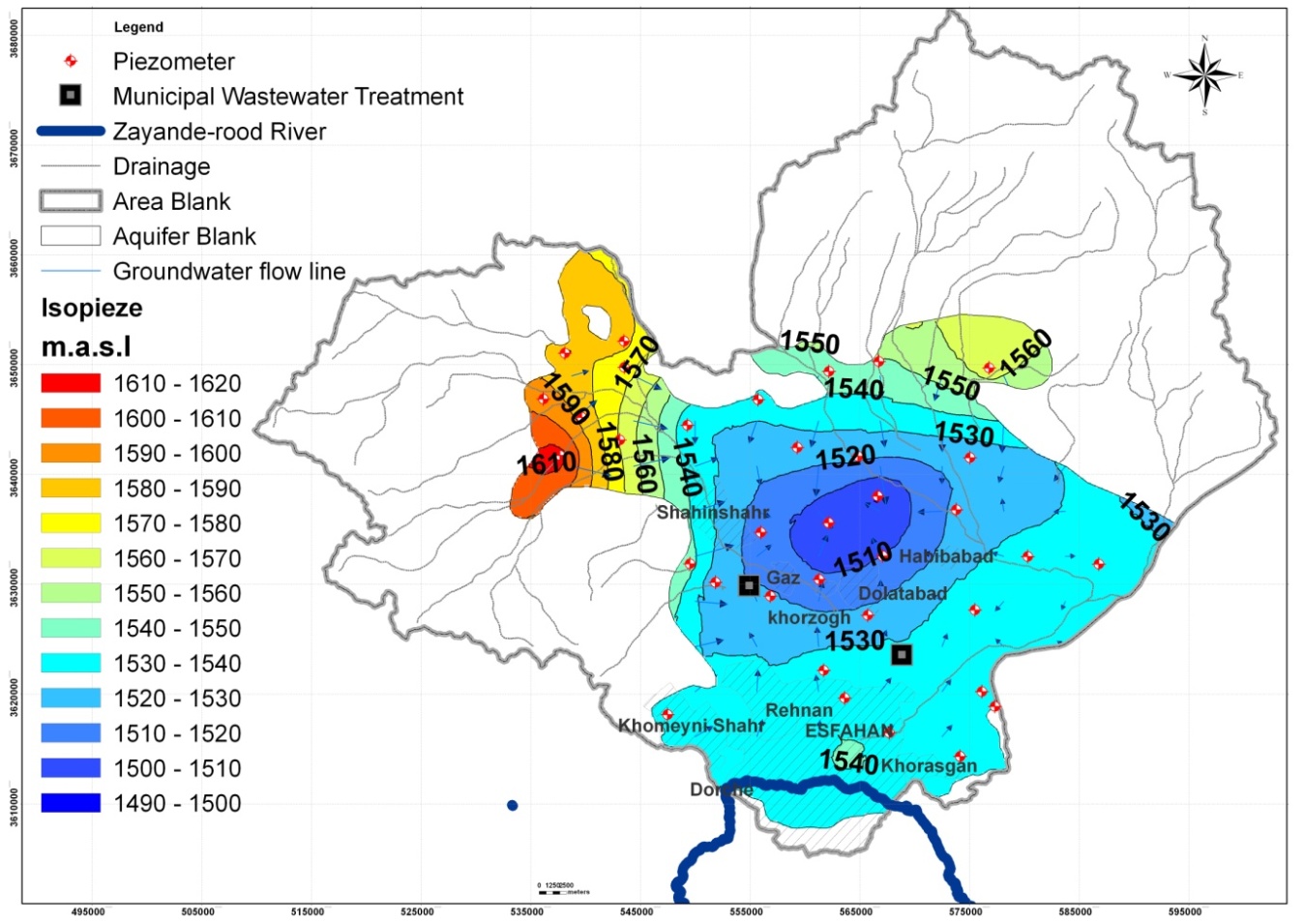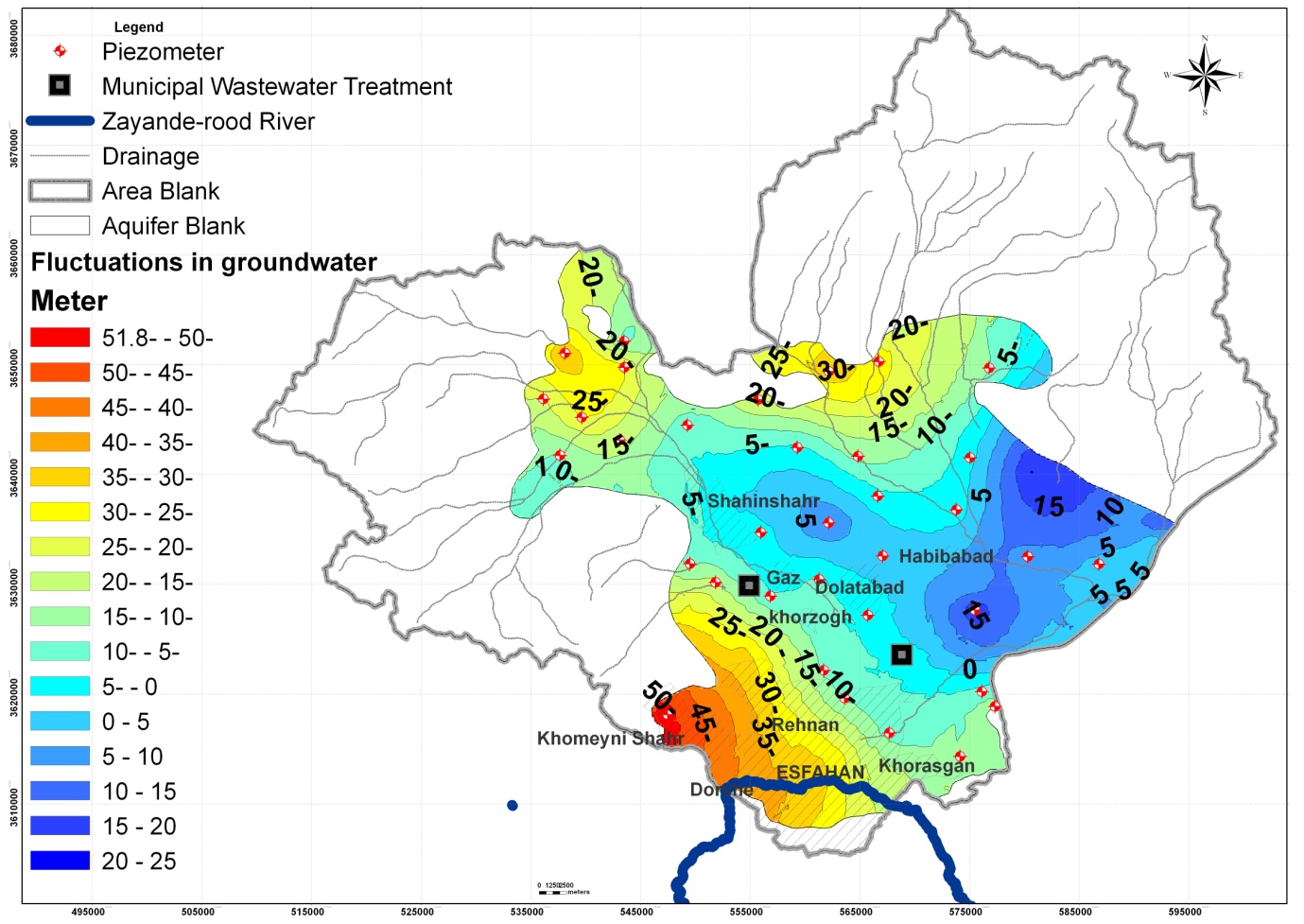-
Paper Information
- Paper Submission
-
Journal Information
- About This Journal
- Editorial Board
- Current Issue
- Archive
- Author Guidelines
- Contact Us
American Journal of Environmental Engineering
p-ISSN: 2166-4633 e-ISSN: 2166-465X
2015; 5(2): 43-46
doi:10.5923/j.ajee.20150502.02

Recovery of Run off of the Sewage Refinery, a Factor for Balancing the Isfahan-Borkhar Plain Water Table in Drought Crisis Situation in Isfahan Province-Iran
Masoud Sayedipour 1, Kaveh Ostad-Ali-Askari 2, Mohammad Shayannejad 3
1MSc, Hydrogeology, School of Earth Sciences, Shahid Chamran University, Ahvaz, Iran
2PhD Student, Department of Water Engineering, Faculty of Civil Engineering, Najafabad Branch, Islamic Azad University, Najafabad, Iran
3Associate Professor, Water Engineering Department, Isfahan University of Technology, Isfahan, Iran
Correspondence to: Kaveh Ostad-Ali-Askari , PhD Student, Department of Water Engineering, Faculty of Civil Engineering, Najafabad Branch, Islamic Azad University, Najafabad, Iran.
| Email: |  |
Copyright © 2015 Scientific & Academic Publishing. All Rights Reserved.
This work is licensed under the Creative Commons Attribution International License (CC BY).
http://creativecommons.org/licenses/by/4.0/

In the drought crisis situation, one of the seeding and reliable sources for balancing the water tables is the water obtained from run off of the sewage refinery. No doubt, recovery and optimal use of runoff from the sewage refinery is possible provided that simultaneously required standards and quality controls for both runoff and the groundwater are observed. In the Isfahan-Borkhar plain zone, two urban sewage refinery are active the runoff of which is disperse in the environment by agricultural activities and percolate into the water table. Qualitative and quantitative effect of run off percolation into the groundwater in this region has been investigated. Quantitative results indicate increase of the hydrostatic (water table) level at a rate of 1 to 20m and qualitative results indicate remaining quality of the groundwater in a relatively desired condition following feeding of water table with runoff.
Keywords: Runoff recovery, Sewage Refinery, Balancing, Water table, Isfahan-Borkhar Plain
Cite this paper: Masoud Sayedipour , Kaveh Ostad-Ali-Askari , Mohammad Shayannejad , Recovery of Run off of the Sewage Refinery, a Factor for Balancing the Isfahan-Borkhar Plain Water Table in Drought Crisis Situation in Isfahan Province-Iran, American Journal of Environmental Engineering, Vol. 5 No. 2, 2015, pp. 43-46. doi: 10.5923/j.ajee.20150502.02.
Article Outline
1. Introduction
- Nowadays, one of the most important consuming water sources in various countries of the world is the groundwater resources. Our country too, regarding the rapid population growth and severe crisis of water sources, particularly during the recent droughts, is intensively depend on these sources therefore the Power Department in order to keep quality and quantity of these sources, has attempted to provide balance in the water tables and one of the crucial performed actions has been the inhibition of developing exploitation of water tables with negative water balance. In this direction, the Isfahan-Borkhar plain water table as one of the water tables with negative balance since many years ago has been considered as one of the water tables inappropriate for development and its development and exploitation has been inhibited.The understudy region is located almost in the middle of the Gavekhouni catchment and embraces the centre of the Isfahan province i.e. the Isfahan city. Sewage of residential areas of the large Isfahan including the Isfahan city and its surrounding cities is disposed of by the sewage disposal system [1]. Within the Isfahan-Borkhar region, there exist two urban sewage refinery the runoff of which peculates through agricultural activities into the water table. The Shahin-Shahr in province Isfahan, Iran refinery, with a capacity of 20 million m3/gr also through agricultural activities peculate into the land located between Dolat-ababd city (Isfahan province, Iran) and Habib-abad city (Isfahan province, Iran) to the north of the airport. Therefore, regarding the procedure of using runoff in agriculture, about 45 percent of the consumed water making a total of 31 million m3/gr is returned to the groundwater of the region the qualitative and quantitative effect of which on the Isfahan-Borkhar plain water table has been investigated in this research project [2].
2. Materials and Methods
- The Isfahan-Borkhar plain with a surface area of 1606 km2 is continuously qualitatively and qualitatively monitored by the office of basic studies of water resources of the Isfahan Regional water Company via 35 observational and 15 selected wells. In this particular research, i.e. percolation of runoff of the urban sewage refinery into the underground waters of the region and it effect in balancing the water table, the level of the existing observational well has been used to prepare the map of fluctuation of the underground waters. For the quality monitoring too, 11 exploitation wells existing in the region and influenced by runoff percolation have been selected and sampled based on such parameters as the course of the groundwater (Fig. 1) [3]. Based on the studies performed in this research this has been done through two sections of impact of runoff percolation on balance and fluctuations of the groundwater and the second section including monitoring of the groundwater quality.
 | Figure 1. Isopizo map for the underground course of water in the Isfahan-Borkhar plain water table |
|
3. Quantitative Effect of Runoff Percolation on Balance and Fluctuations of the Groundwater Table
- Study of water turnovers in a definite interval emphasis on the principle of conservation of matter and continuity in the water cycle is called water balance. In preparing the water balance of a region it is an inevitable necessity to consider all inflows and outflows consistent with the existing realities Regarding the Isfahan-Borkhar plain the most important entry flows to the water table include underground flows, precipitations on the plain surface, feeding from the river, return of the river, return of the agricultural water, drinking water and industry. Drought of the recent years has led to decrease or elimination of feeding flows to the water table. In this direction, drying up of the Zayandeh-rood River as one of most principal feeding flows to the Isfahan-Borkhar plain water table has severely influenced fluctuations of the groundwater in this region. Less than 50% of the water table’s feeding flow has been due to the water flow in the Zayandeh-rood River which has been eliminated now. Therefore, exploitation of the groundwater as a discharging flow and decrease of feeding flows has led to lowered level of groundwater and negative balance in this water table. In spite of the conditions imposed on the water table and the drought crisis in the region, study of the map of groundwater fluctuations indicate using o the groundwater level in a section of a centre of this water table embracing a surface area of about 82km2. On this area, level of the groundwater has risen from 1 to 20 meters and has led to its balancing. The only factor effective on this phenomenon is recovery of runoff of the north and Shahin-Shahr (Isfahan province, Iran) water refinery that through consumption in agriculture has percolated in to the water table and caused such a situation. The map of fluctuations of the Isfahan-Borkhar plain water table and location of the sewage refinery, and the quality monitoring points has been displayed in figure 2. [4].
 | Figure 2. Fluctuation map of the groundwater level, water refinery and the quality of monitoring points in the Isfahan-Borkhar plain water table |
4. Qualitative Effect of Runoff on Groundwater and Its Monitoring
- Water quality monitoring can be defined as a planned program and continuous inspection (direct), study of potential causes, existing changes, analysis of the past qualitative modifications, and forecasting the future qualitative changes. Domain of the groundwater qualitative monitoring can be defined as assessment of conditions and trends of water quality compared with standards and measures at local level or basin level. This qualitative control should indicate specified local situation and water quality changing factors in that region. As a whole, local distribution and groundwater quality determination in the course of time is expensive. Therefore, in order to minimize such expenses, this task is performed through geological, hydrological and hydro chemical analyses along with guidelines and standards. In this directive effect of sewage runoff on groundwater of a section of water table of the Isfahan-Borkhar plain region, 11 points were selected for sampling (Fig. 2). Sampling was performed based on the existing standards and sent for analysis to the Regional Water Laboratory. Based on the protocol proposed by the Iranian Water Sources Management Company (2), monitoring of groundwater resources is performed with the objective of determining the effect of runoff percolation including such parameters as TDS, EC, pH, and anions (carbonates, bicarbonates, sulphates, chlorides), cautions (calcium, magnesium, sodium, potassium), nitrate total phosphorous, total nitrogen, focal coliform, BOD and heavy metals (Chromium, Cadmium, mercury, lead). The measured parameters and it results are presented in table (3). For example pH in the samples has been measured to be from at least 6.9p26 to maximum 8p39 which regarding the standards available for agricultural us is between 6 to 8.5. In the existing standards, the desired turbidity level for agricultural consumptions is determined to be maximum 50 ntu. In the samples, its level has been measured to be from 0.08 ntu/p7 to 11.9 ntu/p22. Nitrate level has been assessed only in two points close to the Refinery which fortunately the obtained results indicates this ion’s concentration to be even lower that standard for drinking. All heavy metals have been assessed in the intended region the most important of which include lead with a figure of less than 0.09 mg/l, cadmium less than 0.013 mg/l and chromium less than 0.05 mg/l(3).
5. Conclusions
- In the situation of drought crisis, runoff recovery and its returning to the water table, in the understudied Isfahan-Borkhar plain is considered as a factor effective on balancing part of the water table and such physical and hydraulic conditions as existence of clay layers and high thickness of the unsaturated section in it has led to occurrence of such phenomena as surface absorption, ionic exchange, and discharge of polluting parameters caused by percolation of runoff from the urban sewage refinery to the underground water. Study of the performed analyses (physical, chemical, microbial, biochemical, and heavy metals) shows as a whole relatively desirable condition of the groundwater in the under studied Isfahan-Borkhar plain region and meeting standards required for consumption for agriculture [5, 6].
 Abstract
Abstract Reference
Reference Full-Text PDF
Full-Text PDF Full-text HTML
Full-text HTML